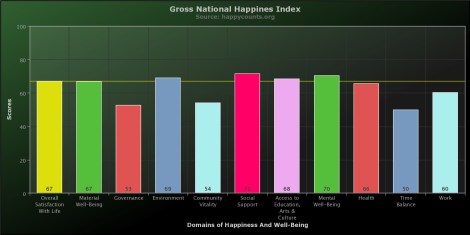
Shutterstock / Rafal OlkisBiking can make you happier.
Editor’s note: We’re encouraging Grist readers to take the Gross National Happiness survey, a project of The Happiness Initiative. Then tune back in next week to find out how your results compare to those of the Grist audience as a whole and other survey takers.
The case for happiness
It’s clear to those who’ve been paying attention that our current economic behaviors are on a collision course with the earth’s limits. We are now using resources and generating wastes at rates 40 percent higher each year than can be sustained. If every country on earth were to consume at U.S. levels, we’d need five planets.
Part of the problem is our current metric for societal success: Gross Domestic Product, or the market value of goods and services produced in a given year. The United States has the largest GDP of any country in the world, and orthodox economists would argue that our massive GDP makes the U.S. the most successful country in the world. But the facts tell a different story:
- The United States has the widest rich-poor gap of any rich nation, with the top 1 percent of earners garnering more than 20 percent of our annual income.
- Rates of poverty in the U.S. are the highest among wealthy countries, and more than double the average in Europe.
- Americans spend at least twice as much on health care per capita as citizens of any other country, yet U.S. life expectancy ranks 51st in the world.
- Americans are more likely to report experiencing stress than are people of 144 other nations.
- Americans consume nearly two-thirds of the world’s antidepressants.
- More than a third of Americans over 45 report being chronically lonely, up from 20 percent in 2000.
- The United States ranks 11th in “life satisfaction,” according to a Gallup-Healthways poll, but well below Denmark, Finland, Norway, and the Netherlands.
- The United States is the only wealthy country without national policies for paid sick leave, paid maternity leave, paid holidays, and paid vacations.
Yet sadly, the American economic model is becoming more dominant, even in Europe. We are sacrificing our health, happiness, social connections, leisure time, and the environment in the blind pursuit of growth. We can’t go on like this.
Fortunately, there are some hopeful signs of change.
A new direction
In 2011, the United Nations passed a resolution recognizing that GDP “is an insufficient guide for safeguarding the well-being of people or our future.” Instead, the U.N. urged governments across the globe to start measuring happiness and well-being “with a view to guiding public policy.”
The U.N. was responding to a global trend toward replacing the singular goal of material well-being with comprehensive measures of well-being or happiness. Countries including Australia, Canada, Ireland, Japan, and the United Kingdom are now starting to measure the happiness of their citizens. These subjective studies could bring more balance to policymaking, helping us understand where people perceive themselves to be hurting and thriving.
We at The Happiness Initiative have been using a survey called the Gross National Happiness Index to measure overall life satisfaction as well as 10 “domains” of well-being. The survey was developed by a team at San Francisco State University and inspired by the government of Bhutan, which has made the happiness of its citizens its top goal since its king declared 40 years ago that “Gross National Happiness is more important than Gross National Product.” Here are the components of happiness we’re aiming to measure:
- Overall satisfaction with life: prevalence of positive and negative emotions
- Material well-being: income, financial security, level of debt, employment security, quality of housing
- Environment: quality of water, air, soil, forest cover, biodiversity, access to green areas and transportation
- Governance: involvement, responsibility, honesty in government
- Community vitality: relationships, sense of belonging, safety, volunteerism
- Cultural vitality: spectatorship and participation in cultural and sports events
- Education and learning: participation in formal and informal education
- Physical health: health policies and self-rated health
- Time balance: balance of time between leisure and work, enjoyment of life activities
- Psychological well-being: optimism, self-esteem, sense of competence
- Workplace experience: employment satisfaction, job conditions, productivity, compensation
Here are the average scores of more than 20,000 people who’ve taken the survey so far:
Take 10-15 minutes to complete the survey yourself and find out how you compare to the average, and then check back next week to find out how you compare to other Grist readers.





